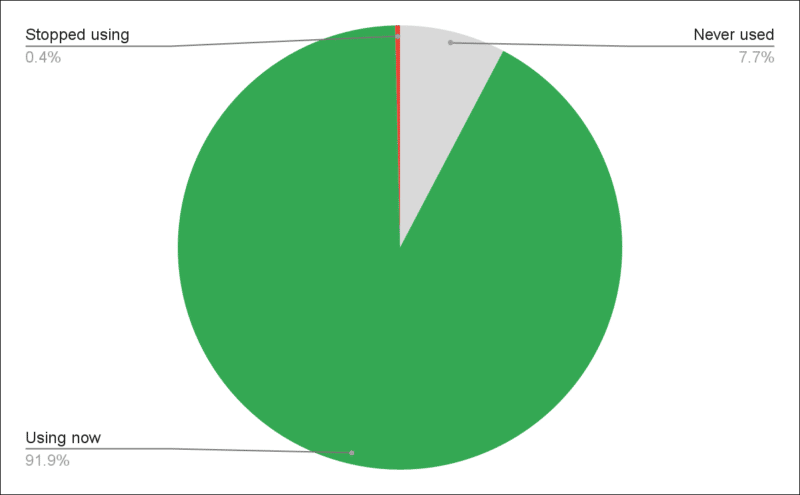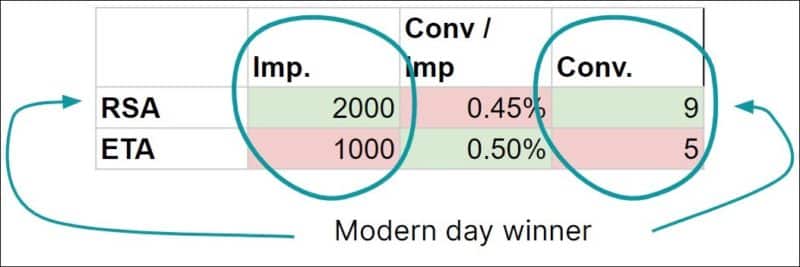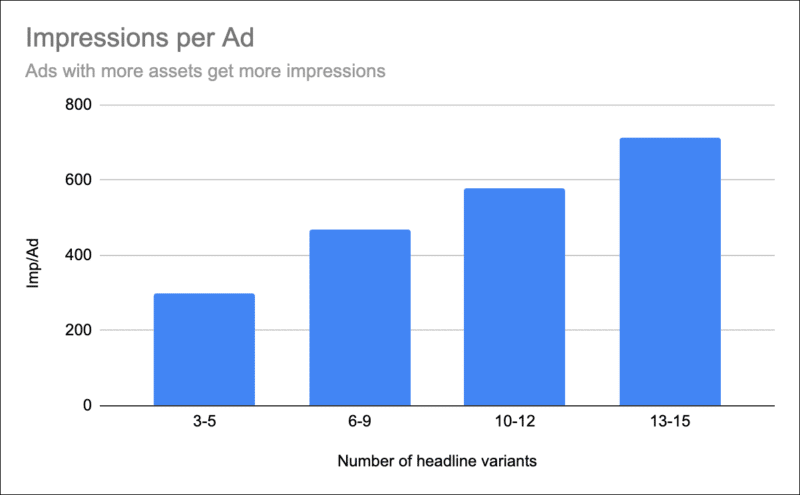
After years of perfecting ad optimization strategies for expanded text ads (ETAs), advertisers must now re-learn optimization for responsive search ads (RSAs), the new default ad text format on Google since July 2022. Due to their newness, a strong consensus about optimization best practices for RSAs has yet to emerge. But there are known pitfalls we already know to avoid.
Read on if you’d like to learn some of the most common mistakes advertisers make when working with RSAs and how to use PPC management tools like the Google Ads UI or Optmyzr to prevent or fix them.
Automation layering puts humans in charge of improving PPC performance
RSA optimization follows a now familiar pattern where the best results are achieved by leaning into automation rather than fighting it. Here’s the formula for success in the age of PPC automation which Optmyzr’s co-founder Fred Vallaeys shared in his book “Unlevel the Playing Field”:
Machines + humans > machines alone
But with a looming recession and more scrutiny on the performance of digital ads, the humans of PPC are about to become even busier than they already are, and organizations might consider foregoing the significant benefits humans can bring to results and rely on just the automations from the ad engines. But for advertisers who want more results, more profits, and less wasted ad spend, technology can come to the rescue in the form of automation layering.
In automation layering, humans create lightweight automations to regain control of ad engine automations. Automation layers can set safeguards and boundaries or feed first-party data into the sophisticated Google AI that now controls much of what humans used to manage. Together this makes PPC perform better and faster while making fewer costly mistakes. The formula becomes:
Google’s AI automations + human-controlled automation layers > Google’s automations alone
So let’s take a look at five of the most common mistakes we see with RSAs and how to fix them with automation layering.
1. Still relying on uneditable legacy ads
As of shortly before the sunset of ETAs, Optmyzr’s analysis of over 13,000 Google Ads accounts found that a whopping 7.7% of advertisers had never created an RSA yet.

Having only ETAs is risky because once they stop performing as expected, they can’t be optimized. They also can’t be edited to reflect new promotions, something you’ll likely need to do as Q4 promotions ramp up across the industry.
Part of the reason some advertisers still rely on uneditable ETAs is that it can be hard to find ad groups that haven’t made the transition to RSAs yet. Those ad groups simply continue to run and may look fine in reports, obscuring the fact they’re running on outdated ad formats.
To transition your final ad groups to RSAs, scripts can come in handy. Optmyzr has an RSA migration script that downloads all ad groups without RSAs and prefills a bulk sheet with suggested ads. Because they’re in a spreadsheet format, it’s much easier to go through it quickly to make edits before posting them back to Google.
2. Ignoring your history of high-performing campaigns
If you ran search campaigns in Google Ads before RSAs became the default ad type, you’re already ahead of everyone starting now, especially if you also followed a few other best-practice guidelines:
- Use of automated bidding or Smart Bidding
- Proper use of seasonality adjustments
- Offline conversion imports
Older accounts also have a leg up because they have more data, and machines thrive on data to learn patterns.
Advertisers transitioning existing accounts can use their best-performing ETA headlines and descriptions to start new RSAs. This action offers on average a 7% lift in conversions at a similar cost per conversion. This migration can easily be achieved with our RSA migration utility for Google and Microsoft.
3. Testing responsive search ads by conversion rate
The single largest mistake, short of ignoring RSAs completely, is when advertisers treat their RSAs like ETAs during testing. RSAs have the unique ability to adapt what they show to boost their relevance to any search query that comes in. Because they are built to increase relevance on the fly, they have better quality scores and get far more impressions than ETAs.
We found that ad groups with RSAs got 2.1 times more impressions than those with no RSAs. These additional impressions are the reason why modern ad optimization strategies must be revised and brought up-to-date as we’ll illustrate next.
The old way of ad optimization favors the ad that delivers the most conversions per impression. But now that the ads, and not just the keywords, play a large role in determining the potential impressions, impressions themselves must also be factored into the analysis.
Look at the example below, where the ETA ad has a roughly 10% better conversions-per-impression ratio but gets only half the impressions as the RSA. The bottom line is the ETA ad delivers fewer conversions, primarily because it gets so many fewer impressions.

Old way: Focused on conversion rates or conversions per impression

New way: Focused on conversions within CPA or ROAS limits
In Optmyzr, advertisers control the algorithm that decides how A/B ad tests are decided. For example, you can limit the analysis to only compare ads that have similar impression volume. By enabling this power-user feature, you avoid pausing ads with lower conversions per impression that would have gotten more conversions due to their outsize impression volume.
4. Not experimenting with pinning
As we said before, we believe that humans + machines > machines alone. In addition to writing good assets, pinning is another easy way for humans to control the machines.
When pinning is taken to the extreme and one asset is pinned to every location, our study found the highest CTRs and conversion rates.

But before you go pin every part of your RSAs, don’t forget that high CTRs and high conversion rates are useless without impressions. The same pinning that produced better CTR and conversion rate is unfortunately responsible for limiting the impressions these ads get.
Google’s machines prefer when you allow them flexibility. In terms of RSAs, we found that the impressions per ad increase as you give the machines more options by adding more assets.

As for the impact of pinning just one asset per location, this leads to significantly fewer impressions for the RSA than when multiple assets are pinned to each location.

Pinning helps you control the machines, so use it to test ways to balance volume with quality. The best way to get statistically meaningful results is by using Google’s built-in ad variations tool which is part of their experiments framework. Optmyzr users can accelerate their own experimentation by using our Campaign Experiments dashboard to stay on top of all the experiments you run across the many accounts and campaigns you manage.
5. Not pairing RSAs with Smart Bidding and Broad Match
Automation likes it when advertisers remove constraints. We saw this in the data above when impressions soar by simply adding more ad text variations to an RSA. This also holds true for removing other constraints. So when you want more conversions, cautiously loosen up the match types to allow RSAs to show your ads for even more queries.
We’re not recommending a wholesale shift to broad match. Instead, test it while paying close attention to the query data and adding negative keywords as needed. This even works for Performance Max campaigns which can have negative keywords, either by asking your Google rep to add them to the campaign or by adding them to a shared negative list that is associated with the Performance Max campaign.
But loosening the reigns is only effective when you combine multiple tools for an effective automation layering strategy. Specifically, RSAs should be used in conjunction with automated bidding. Automated bidding can lower bids when it shows an RSA for a query with a more tenuous relevance to whatever your business sells.
Let’s illustrate this with an example. With a static $5 max CPC bid, the machine will bid $5 regardless of whether it believes the user is 20% or 80% likely to convert. In the case of the 20% probability, a $5 click means a $25 CPA ($5 / 0.20), whereas with the 80% probability, it’ll be a $6.25 CPA ($5 / 0.8). Smart bidding can account for the difference in conversion probability between different queries and help achieve a more consistent ROAS or CPA.
Conclusion
Google is adding more automations all the time and RSAs can drive incremental conversions at a reasonable cost, especially when complemented by other machine learning capabilities like Smart Bidding.
Optmyzr’s PPC optimization suite is evolving right alongside Google and now offers a full range of capabilities for creating, testing, and optimizing RSA assets and the ad groups/campaigns they run in. If you’d like to try it, take advantage of our free 14-day trial.
To learn more about modern ad optimization, sign up for UnLevel to get access to free RSA-focused content from Anne Bui (Puffer), Zenia Johnson (Outside Inc), Jyll Saskin Gales (Jyll.ca) and many more.
New on Search Engine Land

